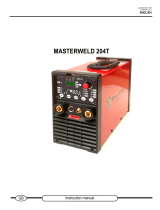Diagnostics and repair instruments and tools 5
3) DIAGNOSTICS AND REPAIR INSTRUMENTS
AND TOOLS
3.1)
Instruments for basic diagnostics
You will need:
- a multimeter with the following scale:
Ohms: in the range 0 to several Mohms
Diode test
Direct voltage (Vdc): from mVdc to 1000 Vdc
Alternating voltage (Vac): in the range 10 Vac to 700 Vac
NOTE: You are advised to use an instrument with an automatic
scale as, theoretically speaking, when the machine is faulty, it is
not possible to foresee the level of the electrical value to be
measured.
- a class 2.5 or higher clamp-on AC-DC ammeter with end of
scale 200A pk
- instead of the clamp-on ammeter, you can use a shunt with
a value of 60 mV @ 150 A.
NOTE:
- Remember that other shunts may do the job just as well,
though a greater capacity means less accuracy, whilst with
lower capacities, the measurement must be taken quickly or
the shunt will overheat.
Once inserted, the shunt is at welding potential
(watch out, above all, for discharges during striking
in TIG HF mode!)
- Nonetheless, in practical terms, a clamp-on ammeter is the
best choice.
3.2)
Tools for repairs
- complete set of open-ended spanners
- complete set of 6-point socket spanners
- complete set of flat-tip screwdrivers
- complete set of Phillips screwdrivers
- complete set of Allen keys
- a Phillips torque wrench for M3 screws with torque settings in
the range 1 to 3 Nxm accurate to 0.1 Nxm.
- a crimping tool for insulated wire terminals (blue, red and yellow)
- a pair of pliers for AMP contacts
- pliers and nippers commonly used with electronic components
- a larger pair of nippers for cutting small thicknesses of sheet
metal
- tongs (suitable size for closing gas pipe clamps)
- a soldering iron for electronic components with min. power 50 W
- portable DIY electric drill
3.3)
Conventions
We have adopted a convention whereby, when you are asked
to take a measurement between two points, such as a b,
the tip of the arrow always indicates where to apply the multi-
meter's red probe (a), whilst the black probe is applied to the
other end (b).
When the arrow between two measuring points is double (e.g.:
c d), the voltage to be measured is alternating (usually at
50 Hz) and, consequently, it does not matter what order the
multimeter's probes are applied in.
In drawings and tables, when a voltage measurement referring
to terminals of components such as diodes, BJTs, mosfets and
IGBTs appears, reference is made to the multimeter being used
in "diode test" mode (such measurements should always be
taken with the machine switched off, and usually give values in
the range +0.10… +0.90 Vdc). In this case, the relevant
symbol appears next to the value to be measured.
Junction measurement (multimeter in "diode test" mode)
Similarly, the following symbols will be used:
AC or DC voltage measurement (multimeter in voltmeter
mode)
Resistance measurement (multimeter in ohmmeter
mode)
Current measurement (clamp-on ammeter or shunt +
multimeter in millivoltmeter mode)
Frequency measurement (multimeter in Hz mode)
Measuring conditions (power source on/off, MMA/TIG opera-
ting mode etc.) are always clearly indicated next to the value to
be measured.
Connector pins are indicated with the name of the actual con-
nector followed by a slash and by the number of the pin; for
instance, CN1/2 indicates pin 2 of connector CN1.
Unless otherwise specified, all measurements should be taken
with the boards in their slots and connected
Remember that testing should always start with a
VISUAL INSPECTION!
Visual inspection reduces the time spent troubles-
hooting and points any subsequent tests in the
direction of the damaged part!





















